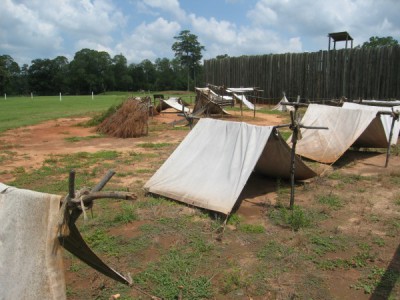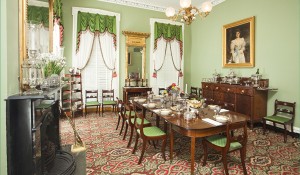We got up and while I got ready to go, Jon enjoyed some time down at the exercise room at the Windsor Hotel (he did say it was too hot though). Then we checked out of the hotel and since the hotel restaurant was almost done with their breakfast period, we asked where else there was to get breakfast in the area. The manager recommended Carter’s, which he said served an authentic southern breakfast. We checked it out. It turned out to be Carter’s Fried Chicken, and they did have a breakfast menu. I’m not exactly sure I would describe it as authentic though – or at least authentic southern breakfast isn’t much different than all the authentic northern breakfasts I’ve had. Scrambled eggs, sausage, Wonderbread, and substitute grits for hashbrowns. Carter’s breakfast was decent but nothing fancy, cafeteria style, served up on a Styrofoam plate with plastic utensils. But it filled us up and we were on our way.
Like I said before, our destination for the day was Andersonville, the confederate Civil War prisoner of war camp. It was called Fort Sumter during the war, but in the later years it became known as Andersonville, named after the closest community. It was located there because it was sufficiently remote as to prevent much chance of a Union raid on the camp, and the community of Andersonville only had about 20 residents during the Civil War, so there wasn’t much chance of their complaining too loudly about having a POW camp in their backyard.
We got to Andersonville close to 10:30 in the morning, and went to the Visitor’s Center. The Visitor’s Center has a museum honoring Prisoners of War from all conflicts that the U.S. has been involved in, from the Revolutionary War to the present. We started out by watching their half hour film from the perspective of POWs. It was a very powerful collection of interviews with people who were POWs going back to World War II, detailing their experiences, both the horrors they lived through and the joy they experienced upon their release. The museum there is well done and offers a lot of information on the POW experience throughout the ages. It is a National Historic Site (and I got a stamp!), and it is all free of charge! They do welcome donations, for the fantastic work they do to preserve this history for future generations.

Andersonville National Historic Site Visitor’s Center
After the film and our visit to the Museum, we checked out the free audio tour from the Visitor’s Center and headed out to see the prison site (just ask for the audio tour at the front desk). The audio tour has a tour of the prison and the cemetery, so you can head over to the cemetery after you are done with the prison and get some good information there too. I’ll talk about the cemetery in my next post.
Fort Sumter was located in this remote area of Georgia to prevent Union troops from being able to easily mount an assault on the prison to free the POWs. The site was originally 16.5 acres, with a boggy creek running through it to provide a water source for prisoners. The camp was designed for about 6,000 people. A few months after the prison opened in February 1864, officials realized that the original 16.5 acre site was not large enough, and the camp was hastily expanded to 26.5 acres. Unfortunately, there was no new source of water in the expanded area. The expanded prison was intended for about 10,000 prisoners, but by June 1864, there were about 26,000 prisoners housed there. At the height of overcrowding, the population was 32,000 prisoners. In all, 45,000 prisoners passed through its gates in the 14 months that it was open.
During construction of the prison, officials reasoned that prisoners could access the upstream area of the creek for drinking water, and use the downstream portion for their latrine. What the officials didn’t count on, however, was that the water had already been tainted by kitchen facilities upstream, so the water was polluted by the time it ran into the camp. So much for that idea… The camp was constructed with a stockade wall and guard towers built along the wall for guards to monitor the prison population. 19 feet within the stockade wall was a light fence that became known as the ‘deadline’, because if you were seen on the other side of that fence, you would be shot on sight. Therefore, of the 26.5 acres of the camp, a significant section of the real estate was not even available to the prisoners.

This picture shows the entire 26.5 acre prison camp – Camp Sumter – Home to 45,000 Union soldiers over a period of 14 months
When the Confederates were building the camp, they cut down all the trees that were on the site, both to use for the stockade walls, and to prevent the prisoners from being able to use the trees as cover for an escape. The unfortunate consequence was that there was absolutely no shelter from the elements on the camp grounds. Prisoners could use whatever they could get a hold of to build a shelter for themselves, but there were not a lot of available resources. As we drove around the site and got out of the car to explore more, it was apparent that this camp would have been unbearable in the hot summer sun. And it would only get worse as the summer got hotter. And the Georgia winter would not have been pleasant either, dressed in rags with no shelter and inadequate food.

A Reconstruction of the Stockade Wall – Jon is Reading the Sign

Re-Creations of Prisoner Shelters – They Called the SheBangs
Due to a combination of polluted water, inadequate food and nutrition and lack of shelter from the elements, prisoners began to die in large numbers shortly after the camp was opened. In all, almost 13,000 of the 45,000 prisoners at Camp Sumter died during the 14 months that the camp was operating. If you were lucky enough to be healthy for awhile, you still had to contend with the Andersonville Raiders, a gang of immoral prisoners who weren’t above using theft and violence to obtain additional resources for themselves. They were armed mostly with clubs, and would steal food and valuables in order to survive – killing the weakened soldiers who tried to resist.
Eventually in July 1864, the Andersonville Raiders were captured by their fellow prisoners, and the camp commander Henry Wirz allowed the prisoners to arrest and try the Raiders, sentence them and carry out their sentences. Sentences ranged from minor punishments like being put in stocks, to more severe punishments such as running the gauntlet – I had to look this up – it is where you have to run back and forth between two rows of soldiers while they strike you with clubs or sticks as you run by.
Apparently some of the Raiders who were made to run the gauntlet got off with only a few blows to the head, but a couple of them were beaten so badly that they later died of their injuries. Six of the Andersonville Raiders were hanged. The prisoners refused to allow the Raiders to be buried with the rest of the prisoners who died honorably, so the Raiders’ graves are separated in the cemetery from the rest. At least after the trials and punishments, prisoners didn’t have to worry about being victimized by their own fellow prisoners. I’m sure it was small comfort.
As the situation with the water got worse, prisoners prayed to God and were blessed with a natural spring that was unearthed in August 1964 by a lightning strike during a torrential thunderstorm. Providence Spring, as it came to be called, had cool, clean water that flowed at the rate of about 10 gallons per minute, enough to provide enough clean water for everyone in the camp. It continues to flow today, and it is now enshrined in a granite building. Ironically, park rangers have marked the spring as having unpotable water – I’m not sure if that is just to limit liability, or because the structure contains lead pipes, or because the spring has been polluted now too. I didn’t test the waters, so to speak.

The Building Erected Around the Providence Spring by Veteran’s Groups in 1901

A View of Providence Spring From the Stockade Wall
Sadly, although Sherman’s troops were within about 20 miles of Camp Sumter during their March to the Sea, the prisoners were not liberated at that time. In fact, they had to endure another miserable winter (1864) and were not released until April 1865 when the war ended. Although conditions had improved somewhat, it was still considered a horrific experience.
Henry Wirz, the camp commander, was the only ranking officer who was executed for war crimes after the Civil War. People were outraged when word reached the north at the end of the war about the conditions the prisoners were subjected to. Lincoln had just been assassinated, and there was not a lot of sympathy for Wirz’s claims that he had done the best he could with the resources he had available. To Wirz’ credit, he had sent a letter signed by many of the prisoners requesting that the North re-establish prisoner exchanges, but the Union would not. At one point, the Confederates even offered to release the prisoners, if only the Union would send ships to the Georgia coast to pick them up.
Ironically, New York’s Elmyra prison had a similar death rate among the Confederate soldiers who were imprisoned there, but the South was in no position to punish the North, having lost the war. I also learned that many of Andersonville’s prison guards suffered the same malnutrition and exposure to the elements as the prisoners, and many of the guards died too. You can draw your own conclusions about whether you believe that the Confederates intentionally starved the soldiers, or if was a cruel result of the circumstances of the time, with even Confederate soldiers and citizens going hungry.
Andersonville prison and cemetery is now a very peaceful place. I wrote about the cemetery in a separate post; you can find it here. While we were there, we saw only about a half dozen others touring the grounds. Actually, I was surprised that there were so few people there. On the grounds – it is very quiet; you can only hear the sounds of nature – there are no sounds of traffic, industry or city life. If you didn’t know what happened here, you would never be able to guess that a place that seems so serene now could have been the site of so much pain and suffering. It was a humbling place to visit.








































